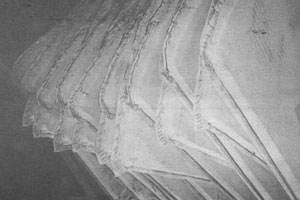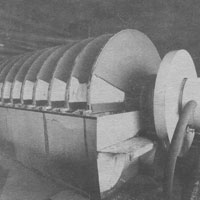Improving the Performance of your Disk Filter
INTODUCTION- The Disk Filter has been around for a very long time. The first patent in fact, was issued in 1918, with drawings that look very similar to today's filters. It may be that your filter
has been in use for a number of years. During that time, operating conditions may have changed; ore grade has probably deteriorated; and the plant has come up with all sorts of "additions", such as fines recovery through flotation, to make filtration more difficult.
Plants seem to be in favor of making things more difficult-never easier. However, there are a number of variables in the operation of a disk filter which it may be time to evaluate.
A Disk Filter provides an unusual combination of variable operating factors.
These are: The SECTORS, The BAGS, SLURRY LEVEL AND DENSITY, CONTROL VALVE DWELL TIME, ROTATIONAL SPEED, and SNAP BLOW, all of which you can find information for in the tabbed navigation provided above.
Hollow versus Surface Grooved Sectors
In a typical hollow 12'6" sector there is nearly a cubic foot of water- all of which has to be removed before drying of the filter cake can start. With the MPTI surface grooved sector, however, drying starts as soon as the sector exits the slurry.
Sectors are mounted on the filter in a 'disk'. However, the filter operates through horizontal tubes, with each tube containing a 'row' of sectors. Double headed filters pull from both ends, with the tubes split in the middle.
Frequently a filter will have some new sectors mixed with the existing. There is a natural tendency to place sectors on the filter in a disk, which is understandable, since the easiest way to remove sectors is in a disk.
CAUTION: mixing different types of sectors on the same row should be avoided as the performance level will be averaged
in the row. In other words, if the filter contains both hollow and surface grooved sectors, they should be placed so that only one type is in any row.
Sector Bags
Every plant is different. So too is the performance of any bag and sector combination when compared between plants. The 'idea' combination at Plant A may bomb completely when it is tried at Plant B. Which says that the only way you will find out what is best for your plant is to test ant test again. Bags, like sectors, should be tested in a row; otherwise, performance is degraded to the lowest.
Closing the bag is all important. The end around neck isn't a problem-twisted wire, rubber bands, poly cables, all are satisfactory provided they are tight. But, the large end of the sector is another matter. If you are using Filter Bags with Velcro Closures, you shouldn't have any problems. But, if you are stapling, or using the old fashioned rope groove, then BEWARE OF THE CORNERS. We have seen situations where it was possible to insert a pencil through the gap in the corner, into the inside of the bag. Where a pencil can go, so can concentrate, leading to rapid wear of sector necks, filtrate tubes and valves. Corners should be completely closed, as in the picture, not folded and wrapped like a Christmas present.
Sector necks will wear when there is a hole in a bag. But, they should not wear under normal usage. If neck wear is taking place, it's like a 'fuse'. It is telling you that too much concentrate is getting through the bag concentrate which will wear the inside of the filter-parts which are very expensive to replace. If filtrate solids are greater than 1%, it's time to talk with the bag people, and to start testing.
Right Way
Wrong Way


Check out the MPTI Maintenance and Bagging page here.
Slurry Level and Density
Needless to say, filtration does not start until the sector is completely immersed in the slurry. The lower the slurry level, the shorter the time available for cake forming. The vaccum system of a disk filter is no different from any pump. You know how the slightest air leak stops the liquid flow. Until the sector is completely immersed, it's just one giant air leak. Therefor, optimum production only occurs when the slurry level is right at its maximum height.
Adding or subtracting water will have a significant effect on concentrate production. Drying ceases when the cake cracks. Adding water to decrease concentrate density may have the effect of preventing cake cracking, giving you a drier cake. Similarly, a slight increase in slurry density may provide improved tons, but, probably at a somewhat higher moisture level. You won't know until you try.
Rotational Speed
Hollow sectors, with more water to move, require a slower rotational speed. Shifting to MPTI Surface Grooved Sectors will mean that you can employ a higher rotational speed (frequently less than one minute per revolution), which will generate a thinner cake- but lots more tons. You won't know your filters optimum speed until you try various speeds under various conditions and tests.
Snap Blow
Snap Blow timing and pressure are important to decent cake discharge. Sometimes, older systems have been delivered without efficient snap blow. For these cases, and where the snap blow system is too worn to bother with, MPTI can supply 'Air Cannons'-a proven way to gain 95+% discharge.

